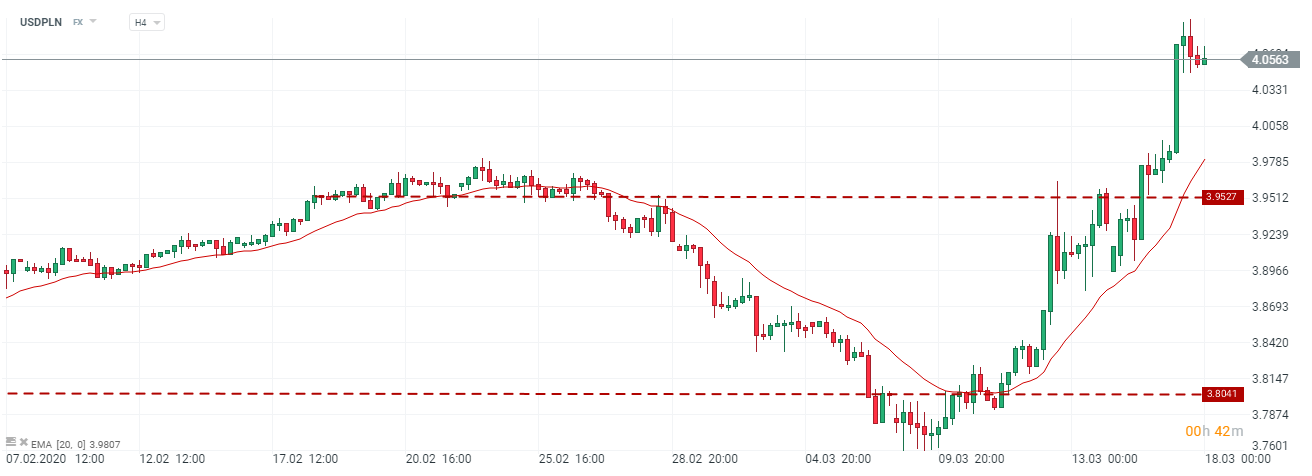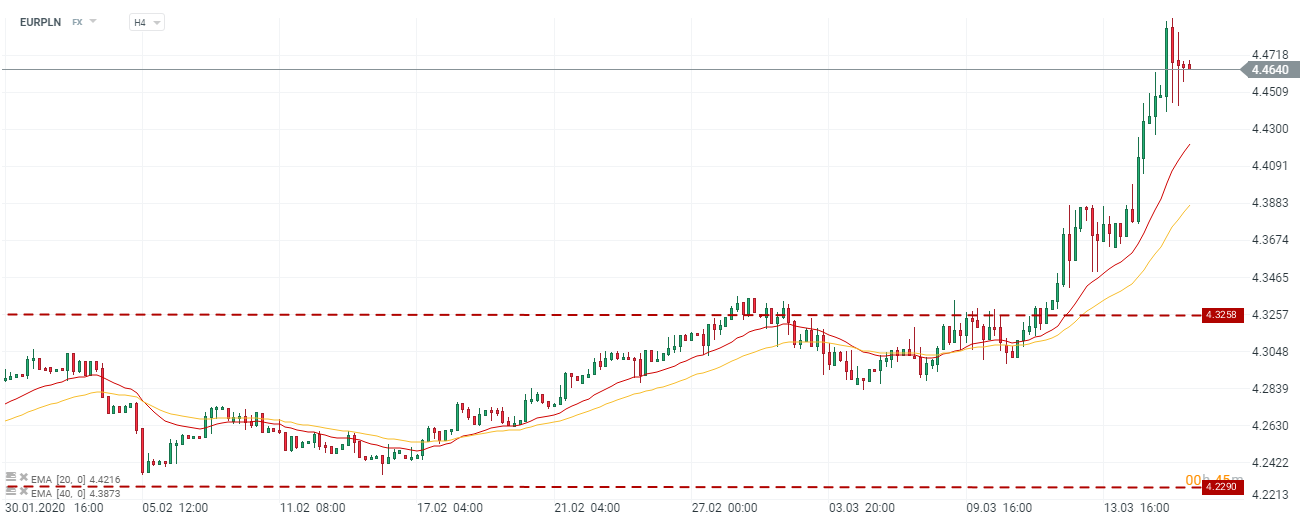The coronavirus digests the markets. Overview of news, currencies and indexes
After mixed data for 2019, January came, which presented equally "undecided" turnover on the currency market. The mood is not the best, and the epidemic began to digest the markets in mid-February. Still, the publications released by top liquidity providers and brokers are quite good. Global caution is not yet visible in the currency exchange volume. Nevertheless, the worst may still be ahead of us and the March readings may be definitely weaker. The coronavirus digests the markets. We are constantly observing declines on the stock exchanges. There is no doubt that the wave of sales is still ahead. For now, there is still a group that buys discounted shares from the market. They are the driving force in relatively good fluidity. Can it change in the near future? Are we going to face more stagnation in the markets? What can we expect in the next month?
Volatility returns to markets
We reviewed the turnover reports published by top liquidity providers and leading companies in the brokerage industry. They are much better than in January, and monthly increases sometimes reach over 40%. However, we should not get used to these results too much. Once again, we emphasize that these are the results for the previous month, in which the increased volatility was the result of growing uncertainty in the market related to the epidemic. In addition, impressive volume increases are very easily linked to really poor results in January, which were worse even compared to the same period in 2019 and 2018. More on this topic we wrote in this article.
There is no global breakdown in terms of recorded. better turnover. Both European industry leaders or companies from the Middle East (including Japanese) have shown similar trends in their reports regardless of the area in which they operate. What will be the trend in March readings? We are already witnessing one of the historical sales on the stock markets. Capital intensively escapes from higher-risk assets, which is certainly reflected in increased volatility. Movements of over 1% on currencies and several percent on indices have become an element of everyday market life. Watching the stock exchanges on a daily basis, we should not have any difficulty finding such spectacular-looking quotes.
Can we talk about a recession?
In fact, the fears that we are at this stage of part of the business cycle, which we call the recession, are fully justified. Indexes behave in a typical bear market fashion. We can take any instrument of this type to see that it has not resisted intense drops. To what extent were they justified? Without over-speculating the answer to this question, the rationale for heading south is mainly in panic than in the (accomplished, not future) economic situation itself. What is currently happening even in Europe is really the beginning of an intensive fight against the epidemic. There is still a long way to go before people and markets. In addition, uninteresting mood is fueled by slowdown.
Everyone talks about the recession today. TV, press and internet forums. Considering only the "textbook" theory, it is more likely to say that we are already behind one slowdown with one foot. The peak of GDP readings is already behind us and economic growth not only does not record better or stable readings, but is gradually declining. It is now highly probable that we are reaching (at least in Poland) the peak of the second macroeconomic indicator, i.e. inflation. It is a conventional indicator of the transition phase from slowdown to recession. However, I am of the opinion that at the moment we are still witnessing a deep slowdown.
Donald Trump's rhetoric is also not as optimistic as it was a few days ago. It takes into account the fact that so far the green island in the sea of global worry - the US, will also face greater economic stagnation. FED even before the actions of the Monetary Policy Council, it reduced interest rates and pumped in substantial amounts of cash to cushion the decline of some sectors. In a recent statement, the head of the White House mentioned that as soon as the epidemic was under control, the United States would leave it as a country with unusually strong economic foundations. New American Dream? But are the realities close to implementation? Undoubtedly, the US has a fairly strong economic position in the world, and the current situation may slightly strain its good condition.

Chart US500 (CFD on S&P 500), interval Hh. Source: xNUMX XTB xStation
Can we talk about a recession? I think not yet. We can safely say that we are in a deep economic slowdown. The environment of low (and falling interest rates) also creates hopes for reducing the effects of the epidemic and support in the form of cheap credit for enterprises. In my opinion, there are still a few inflation readings ahead, the level of which will indicate the alarming state of price increases in the country. Moreover, the depth of the potential crisis, the strength of further declines and possible market demand responses will largely depend on the epidemic's behavior and development.
In the inserted chart we see US 500. Demand responses that occurred on it (interval H4) are not persistent. Rather, they are "natural" momentary reflections. The Federal Reserve, by applying reductions even before the epidemic developed, strongly anesthetized investors to its actions, which we are now witnessing.
How is the zloty doing?
In the broad currency market, the zloty quite hardly endures recent turbulence. Despite the fact that Poland is one of those countries of the Old Continent, which is not so catastrophic (as e.g. in Italy) a virus, it seems to be completely irrelevant on Forex. A good run for the zloty, even on USD / PLN, is long over. The capital flight into American bonds increased the demand for this currency, and the not necessarily good fundamentals of PLN caused its depreciation against the US currency.

USD / PLN chart, H4 interval. Source: xNUMX XTB xStation
Last week we could talk about a moderate weakening of the zloty against the euro. In this, however, we can see a strong appreciation of the USD. It is the result of mediocre moods and growing panic, which we have been observing practically since mid-February. PLN is that it does not react much to the first waves of declines in the markets. We observed a very similar situation in 2008, where it showed its first signs of strong depreciation only after some time. However, it is comforting that most of the world's currencies have a similar weakness to the USD as the zloty, so in the broad market we can observe a collective depreciation.
The last days have also been a time of strong strengthening of the euro (we are talking further in relation to PLN). A wave of monetary easing has come to Poland from almost every corner of the world. In addition to a similar procedure by the NBP, the purchase of bonds directly on the secondary market is definitely more important. Of course, all these activities will allow entrepreneurs to catch their breath, but in my opinion, they will not change much in the zloty.

EUR / PLN chart, H4 interval. Source: xNUMX XTB xStation
European Central Bank he has TLTRO up his sleeve, which is simply a promissory note loan. It is a form praised by most of the market, the only question is how effective and how quickly we will feel its action. Currently, as most EU countries do not hide, solutions are needed that allow observing a relatively quick impact on stock exchanges. All the steps currently taken are, among others, to secure banks against loss of liquidity and to avoid payment gridlocks. Thanks to the ECB's decisive actions, the euro is gaining strength mainly as the base currency for most exotic currencies. What's more, the current situation on EUR / PLN quotes makes you think "it won't be any higher". Probably a large proportion of investors now expect a solid correction and return to healthier prices, where the euro was much cheaper. However, I would not be so favorable to the scenario of a quick reversal of the trend.
It is worth adding that the current situation creates a very good environment for recently discounted government bonds. Undoubtedly, operations related to changes in interest rates will be ahead of us in the near future. Therefore, fixed interest rate debt securities will be a better investment. On the basis of this, we can observe a greater strengthening of USD due to the relocation of assets into US bonds.






















![Forex Club – Tax 9 – Settle tax on a foreign broker [Download the Application] Forex Club - Tax 9](https://forexclub.pl/wp-content/uploads/2024/02/Forex-Club-Podatek-9-184x120.jpg?v=1709046278)
![Trading View platform – solutions tailored to the needs of traders [Review] trading view review](https://forexclub.pl/wp-content/uploads/2024/03/trading-view-recenzja-184x120.jpg?v=1709558918)
![How to connect your FP Markets account to the Trading View platform [Guide] fp markets trading view](https://forexclub.pl/wp-content/uploads/2024/02/fp-markets-trading-view-184x120.jpg?v=1708677291)
![How to invest in ChatGPT and AI? Stocks and ETFs [Guide] how to invest in chatgpt and artificial intelligence](https://forexclub.pl/wp-content/uploads/2023/02/jak-inwestowac-w-chatgpt-i-sztuczna-inteligencje-184x120.jpg?v=1676364263)





![Izabela Górecka – “Success on the market depends not only on knowledge, but also on emotional stability” [Interview] Izabela Górecka - interview](https://forexclub.pl/wp-content/uploads/2024/04/Izabela-Gorecka-wywiad-184x120.jpg?v=1713870578)
![WeWork – the anatomy of the collapse of a company valued at $47 billion [WeWork, part II] wework bankruptcy story](https://forexclub.pl/wp-content/uploads/2024/04/wework-bankructwo-historia-184x120.jpg?v=1711729561)
![Adam Neumann – the man who screwed up Softbank [WeWork, part AND] adam neumann wework](https://forexclub.pl/wp-content/uploads/2024/04/adam-neumann-wework-184x120.jpg?v=1711728724)



![The most common mistakes of a beginner trader - Mr Yogi [VIDEO] Scalping - The most common mistakes of a beginner trader - VIDEO](https://forexclub.pl/wp-content/uploads/2024/03/Scalping-Najczestsze-bledy-poczatkujacego-tradera-VIDEO-184x120.jpg?v=1711601376)
![Learning patience: No position is also a position - Mr Yogi [VIDEO] Scalping - Learning patience - No position is also a position - VIDEO](https://forexclub.pl/wp-content/uploads/2024/03/Scalping-Nauka-cierpliwosci-Brak-pozycji-to-tez-pozycja-VIDEO-184x120.jpg?v=1710999249)
![When to exit a position and how to minimize losses - Mr Yogi [VIDEO] Scalping - When to exit a position and how to minimize losses - VIDEO](https://forexclub.pl/wp-content/uploads/2024/03/Scalping-Kiedy-wyjsc-z-pozycji-i-jak-minimalizowac-straty-VIDEO-184x120.jpg?v=1710336731)



















Leave a Response